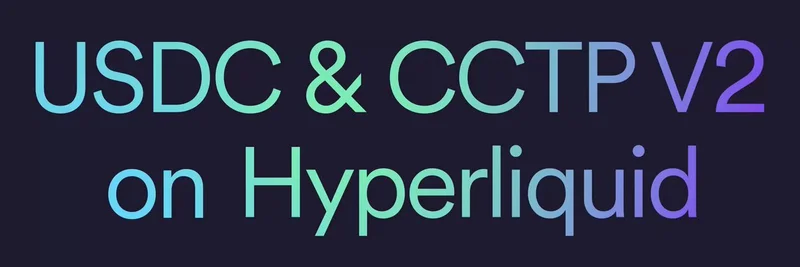Circle, a leading player in the stablecoin market, has announced the upcoming integration of native USDC and CCTP V2 on Hyperliquid, a high-performance blockchain designed for decentralized finance (DeFi). This move is set to enhance the ecosystem's capabilities, offering users and developers a range of benefits that could revolutionize cross-chain transactions and DeFi applications.
What is USDC and CCTP V2?
Before diving into the specifics of this integration, let's break down the key components:
- USDC (USD Coin): A stablecoin pegged to the US dollar, issued by Circle. It is fully reserved and redeemable 1:1 for US dollars, making it a trusted digital dollar for global transactions.
- CCTP V2 (Cross-Chain Transfer Protocol Version 2): An advanced protocol that facilitates frictionless and secure transfers of USDC across different blockchains, enhancing capital efficiency and user experience.
Hyperliquid: A High-Performance Blockchain for DeFi
Hyperliquid is not just another blockchain; it's engineered for speed and efficiency, particularly for DeFi applications. It comprises two main components:
- HyperCore: This includes native primitives like an order book decentralized exchange (DEX), which is crucial for trading activities.
- HyperEVM: A general-purpose smart contract platform that allows developers to build applications that can access the deep liquidity provided by HyperCore.
The integration of native USDC and CCTP V2 will occur on the HyperEVM, enabling seamless deposits and interactions within the Hyperliquid ecosystem.
Benefits of Native USDC on Hyperliquid
The deployment of native USDC on Hyperliquid brings several advantages:
For Traders
- Perpetuals and Spot Trading: Traders can use USDC as collateral for perpetual contracts or as the quote asset for spot trading pairs. This stability is crucial in the volatile world of crypto trading.
- Institutional On/Offramps: Through Circle Mint, eligible users can access institutional-grade on/offramps, facilitating easier entry and exit from the crypto market.
For Developers
- Fast Settlements: USDC enables quick settlements within HyperEVM applications, which is vital for financial applications that require real-time processing.
- Cross-Chain Transfers: With CCTP V2, developers can build applications that allow users to move USDC securely between Hyperliquid and other supported blockchains, enhancing interoperability.
- Stable Value: USDC's design to maintain a stable value makes it an ideal choice for applications that need a reliable digital dollar.
Key Use Cases
The integration opens up a plethora of use cases across the Hyperliquid ecosystem:
- DeFi Applications: Developers can leverage USDC for various financial applications, from lending and borrowing to complex derivative products.
- Cross-Chain Onboarding: Users can seamlessly onboard onto Hyperliquid from other chains, thanks to CCTP V2, which supports efficient liquidity routing.
- Treasury Management: Businesses and protocols can use USDC for treasury rebalancing and other financial operations, benefiting from its stability and ease of transfer.
What to Expect
Circle has outlined that more details will be shared as the launch approaches. Users and developers are encouraged to stay tuned and engage with the Circle team on Discord for any questions or further information.
Conclusion
The integration of USDC and CCTP V2 on Hyperliquid marks a significant step forward for the DeFi space. It promises to enhance the platform's capabilities, offering a robust infrastructure for decentralized applications and seamless cross-chain transactions. As the crypto landscape continues to evolve, such integrations are crucial for fostering innovation and improving user experience.
For those interested in the technical specifics, the mainnet and testnet addresses for USDC on Hyperliquid will be announced soon. This development is part of Circle's broader strategy to expand the utility of USDC across multiple blockchains, solidifying its position as a cornerstone of the DeFi ecosystem.
Stay informed and ready for the launch, as this could be a game-changer for both traders and developers in the Hyperliquid community.



